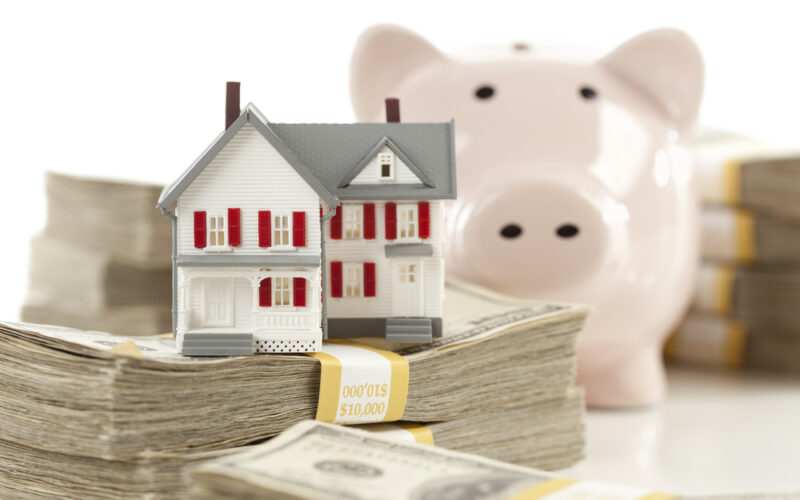Purchasing a house sometimes or even most times involves borrowing money to be able to afford a house. Regardless of how big your mortgage is, you most certainly need to have some cash at hand for a down payment. As such, 99% of people believe that the down payment of a house is worth 20% of the home value which turns out to be a major roadblock for most home buyers. However, in this post, we will realize how much an average down payment can cost, the average percentage of the down payment of a house for repeated and first-time buyers, and what an average house down payment is for Texas residents or one looking to relocate to Texas.
What Is a Down Payment?
A down payment is a price you pay in advance for a large purchase. It could either be a car or a house which is expressed in the price percentage. The down payment is your donation toward the purchase and symbolizes your initial ownership stake in the home when applying for a mortgage to buy a house. The remainder of the funds is provided by the lender for the purchase of the property.
Most mortgages demand a down payment. There are certain exceptions, however, such as VA and USDA loans, which are backed by the federal government and do not often require down payments.
Average Down Payments on a House
Americans have differing ideas on the average down payment depending on their social standing. The National Association of Realtors found that first-time buyers put down only 7% on a home, while repeat purchasers put down 16%. Knowing this, a down payment is less than most people think. Moreso, a poll also revealed that only 2 out of 5 people think 20% is the necessary down payment for a house.
This widely-held misunderstanding about the 20% down payment has deterred many Americans from purchasing a home. It’s vital to remember, though, that the average percentage for a house down payment differs for each state. Several variables affect an average down payment for a house, including the percentage of the home price, geographic location, currency fluctuations, and accessible loan programs.
The majority of American purchasers will be relieved to learn that average down payments are lower than anticipated. The average down payment is only 5%, which increases the number of people who can fast track their way to becoming a homeowner. Although a big down payment can reduce a possible mortgage down payment, a lower down payment helps buyers to save time and (current) money.
Minimum Down Payment Requirement for a House
Putting down at least 20% on a property increases your chances of getting accepted for a mortgage at a reasonable rate and avoiding mortgage insurance.
You can, however, put down less than 20%. The down payment cost on a house varies based on the type of mortgage:
#1. USDA Loans
There is no necessary down payment for this sort of loan; however, the home you want to buy must be in a rural or suburban area for you to qualify. There are also income restrictions that all members of your household must meet in order to qualify for a mortgage down payment deduction.
#2. VA Loans
You can waive the standard down payment if you qualify for this loan. The VA does not require a down payment because it is a government-backed loan. However, your eligibility is contingent on a number of factors, including the length of your military service and the cause for your discharge. Spouses of active military members or veterans who died in a service-related accident are eligible for this sort of loan.
#3. FHA Loans
These are government-backed loans, just like VA loans. Nevertheless, instead of being down payment-free, it has less stringent financial and credit restrictions, allowing you to get closer to paying the minimal down payment on a home. The FHA requires a 3.5% down payment and a credit score of 580 to qualify.
#4. Conventional Loans
In recent years, the conditions for each type of housing under this loan have become more dependent on your credit score. If your credit score is above 620, it may be possible to reduce your monthly cost. Keep in mind that, while certain lenders may want a 7% down payment, a conventional loan requires only a 3% down payment. The higher your credit score, the more creditworthy you appear.
#5. Jumbo Loans
Because of the cost of bigger loans and increased risk for the lender, jumbo loans require a higher down payment on a house.
Borrowers will often be required to put down a minimum of 10% on these larger loans. It’s also customary to use 20%, but it’s not essential. Depending on the mortgage provider you work with, some jumbo down payments might start with as little as 5%. In order to be eligible for a jumbo mortgage, lenders may require one year’s worth of financial reserves.
How Much Is Average House Down Payment Cost
Your ideal house down payment cost will be determined by your objectives and financial position. A bigger down payment will result in a cheaper monthly mortgage payment, but putting too much down may leave you cash-strapped when you move in.
To assist you in determining the appropriate house down payment cost, consider the following:
- To examine how the house down payment cost affects the monthly mortgage payment, use a mortgage calculator.
- Make a budget and keep enough money in the bank for house maintenance and emergencies.
- Use only a portion of your savings for a down payment. After you buy a house, you’ll still need money for other expenses.
- Finally, do some comparison shopping. To get the best deal, compare mortgage rates and programs offered by lenders, as well as costs.
Percentage of Average Down Payment on a House
The National Association of Realtors (NAR) evaluated house purchase trends in the United States in its 2021 report. According to the NAR, the typical down payment for all buyers was a 12% percentage based on the house value.
The following percentage of average down payment on a house was also broken down by age group, according to NAR.
- All buyers: 12%
- At age 22-30: 6%
- Age 31-40: 10%
- Age 41-55: 13%
- From Age 56-65: 18%
- Age 66-74: 23%
- Age 95-95: 21%
Some first-time homebuyers will be able to save more money for a down payment on a new home than others.
According to the NAR survey, home purchasers saved for their down payments for an average of three years. Furthermore, repayment of student loans and credit card debt is the most prevalent expense that causes people to put off saving for a down payment or a home purchase.
Fortunately, saving for a 20% down payment isn’t compulsory for anybody. That is why low- and no-down-payment mortgages are available. However, putting down 20% comes with a lot of advantages.
Advantages of Putting Down 20% Of House Payment
While it may not be essential to save up enough money for a 20% down payment, there are advantages. You’ll have a lower monthly mortgage payment if you put down 20%. (because you paid for more of the house upfront). Plus, a greater down payment usually means you’re financially secure and have a good credit risk, which means you’ll obtain a better interest rate.
Below are some of the main benefits of putting 20% down:
#1. Lower Monthly Payment
your financial records can determine how good or terrible your month went, so it’s no surprise that for both first-time and repeat buyers, lowering monthly payments should be a top priority.
Because the amount borrowed is proportionate to the amount you are willing to put down, making the typical down payment may be quite beneficial. As a result, if you can put down 20%, your loan will be significantly reduced, allowing you to shift money that would have been spent paying your lender into savings or investments.
#2. No Mortgage Insurance
There is no need for mortgage insurance.
The amount that a borrower must pay to a private insurance firm is known as private mortgage insurance (PMI). It’s almost always compulsory on all conventional loans, and it’s intended to protect the lender in the event of a default.
Mortgage insurance cost prices vary depending on the type of loan and the lender’s criteria, but it normally ranges from 0.5% to 1% of the annual home loan total. By putting the normal 20% down payment, you can avoid purchasing this type of insurance.
#3. Lower Mortgage Interest Rates
Most lenders charge monthly. In some circumstances, the mortgage interest rate of a house down payment expresses as a percentage of the principle. Depending on the lender, a bigger mortgage down payment can reduce this rate. Lenders take into consideration the risks taken by each buyer, especially first-time buyers. So to be on the safe side lenders demand to know the financial status of the borrower.
#4. Possibility of Obtaining a Mortgage
Paying the standard down payment shows your lender you can be trustworthy; lenders assess risk via a loan-to-value ratio (LTV). The more money you put down, the less risky you are. Lenders raise mortgage rates to reduce risk, so putting more money down may qualify you for a lower rate. A greater down payment reduces your LTV, increasing your chances of securing the mortgage you want.
#5. Better Financing Options
Having strong credit and making regular standard down payments can help you get better home loan conditions and lower mortgage insurance rates. The quantity of down payments you make affects the size of your mortgage insurance, the time it must be paid, and the premium prices you are likely to incur.
Disadvantages of Putting Down 20% Of House Payment
A 20% down payment may help save money, but there are several reasons why it may not be realistic. Waiting to save 20% for a down payment may be too costly for some. The price of your future house may rise while trying to save that percentage of money for a down payment and rent. So paying less than 20% down may be worth it to get into your first house and develop equity faster.
Some people prefer a higher down payment than others. A mortgage loan officer can help you assess what is best for you based on the benefits of various down payment amounts.
How to Save for a Down Payment on a House
Because putting money down for a typical down payment has apparent advantages, it’s strongly necessary that you save money. The average American saves for years in order to qualify for lower interest rates and lower monthly payments; here are some pointers to help you start on your path to being a qualified homebuyer.
- Consider the Amount You’ll Require
- Make a monthly budget plan
- Reduce spending that isn’t essential
- Start saving your money in a savings account
What Is Earnest Money? How is It Differ From a Down Payment?
Earnest money, also known as a good faith deposit, is money that goes with your offer and shows the seller that you’re serious about your offer, whereas a down payment is part of your mortgage loan agreement with the lender. People often put down payments and earnest money deposits together. A third party, such as a title company, puts the earnest money deposit in a separate escrow account as soon as they sign the contract for the house. When the deal is over, it goes toward the house down payment or another cost.
In a competitive market, an earnest money deposit (EMD) might range from $500 to 10% of the buying price. It usually ranges between 1% and 3% of the home’s purchasing price.
If there are contingencies put into the purchase agreement, earnest money may be returned if specific requirements are met, such as the home failing to pass inspection, appraising below the sale price, or your mortgage loan being denied.
Average Down House Payment Texas
Purchasing and making a payment for a house in Texas is a significant achievement, but the process can be lengthy. Several factors, such as your financial state, market conditions, and the local economy, can influence both the time it takes to find a home and the price it costs.
Mortgage lenders in Texas often require you to put down 20% of the house purchase price as a down payment. For a $289,252 property — the average house value in Texas — that would be $57,850. You can make a house down payment of less than 20% of the purchase price — $57,850 in Texas — but you’ll have to pay mortgage insurance and pay higher interest over the life of the loan.
You, however, have the option of lowering your down payment.
VA and FHA loans, for example, allow you to contribute 0% and 3.5% of the buying price of your home, respectively. Even conventional loans allow for 3-5% down payments (though the minimum varies by lender).
Do You Require Assistance in Making an Average Down Payment on a House in Texas?
There are assistance options for average house down payment available to Texas citizens. You could get a grant or a second mortgage to offset your closing expenses or down payment if you qualify for one of these programs.
You might be qualified for one of the following DPA programs in Texas:
#1. My First House in Texas
The My First House in Texas program provides first-time buyers and veterans with a 30-year, low-interest mortgage worth up to 5% of the purchase price.
The first mortgage must come from a Texas Homebuyer Program-approved lender, and qualified buyers must have a credit score of at least 620. Purchase price and income restrictions exist, and they differ by county.
#2. My Choice Texas House
The My Choice Texas House program gives the first mortgage the option of adding up to 5% average down payment assistance. A 30-year, 0% interest second mortgage is available to help with the down payment.
First-time and repeat homeowners with credit scores of 620 or above are eligible for this program. The purchase price of a home and the household income restriction apply, and they differ by county.
#3. Home Sweet Texas Home (TSAHC)
Through its Home Sweet Texas Home Loan Program, the Texas State Affordable Housing Corporation (TSAHC) provides qualifying homeowners either a grant or a deferred forgivable second loan.
The borrower must have a credit score of at least 620 to qualify. The purchase price of a home and the household income restriction apply, and they differ by county.
Conclusion
In conclusion, the typical down payment for a house in the United States is only about a percentage of 5% of the loan cost. There are, however, a few ways that you might be able to become a homeowner with no down payment based on the type of loan you get. Even if you have bad credit, you can still do it, even though. Depending on the type of loan you get, the minimum down payment you have to make could be different. This could be because of your credit score, mortgage rate, and LTV ratio, among other things.
FAQs
How much is a normal down payment on a house?
Making a down payment of at least 20% is advisable for better mortgage rates and terms. In America, however, the typical down payment on a home is 5%. The majority of first-time home purchasers in the United States put down 7% or less, whereas the average mortgage down payment for repeat house buyers is roughly 16%.
Is it worth putting 20% down for a house?
Yes, it is. You can reduce your monthly payment and avoid paying mortgage insurance or lower your mortgage interest rates by putting down 20% on your house. Paying the 20% boosts your chances of gaining a lender’s trust, giving you the leverage to negotiate better loan terms.
What should you NOT do before buying a house?
Because making a larger down payment on home offers numerous advantages, you must begin saving immediately. Here are two bits of advice: make every effort to maintain your employment stability, and consider your debt-to-income ratio before making any major investment decisions.
How much is a downpayment on a 300k house?
If you are purchasing a $300,000 home, you’d pay 3.5% of $300,000 or $10,500 as a down payment when you close on your loan. Your loan amount would then be for the remaining cost of the home, which is $289,500. Keep in mind this does not include closing costs and any additional fees included in the process






